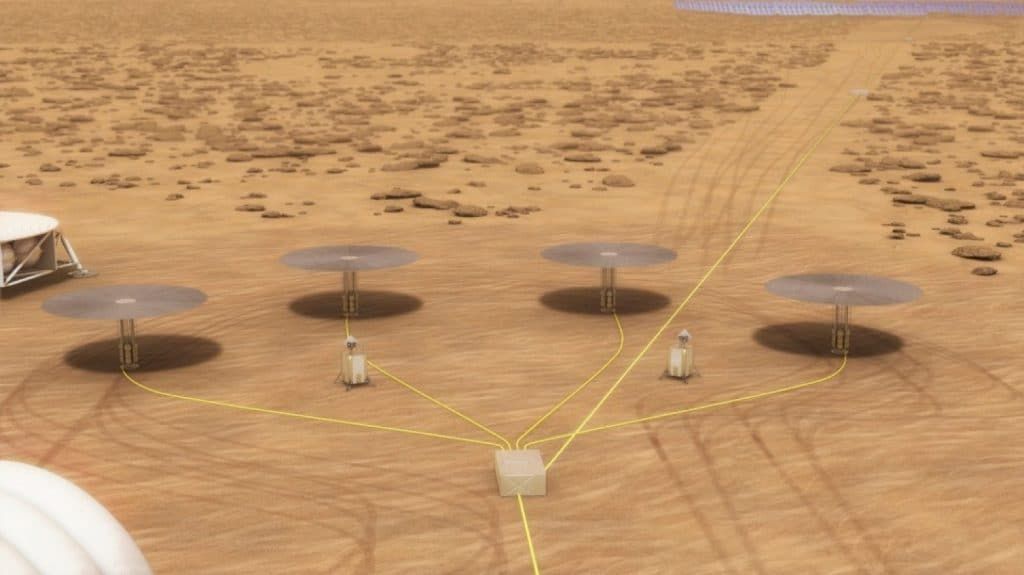Houston, are we going to have a problem with space nuclear power?
By Beau Rideout | July 19, 2021
 The Kilopower project, a partnership between NASA and the National Nuclear Security Administration, developed this concept for a system with four 10-kilowatt nuclear reactors that could supply power for a long-duration, crewed mission on Mars. Credit: NASA
The Kilopower project, a partnership between NASA and the National Nuclear Security Administration, developed this concept for a system with four 10-kilowatt nuclear reactors that could supply power for a long-duration, crewed mission on Mars. Credit: NASA
Nuclear propulsion is the fastest way to send a manned mission to Mars, as the United States proposes to do in the late 2030s. But nuclear power can also be useful for other activities in space that require more electricity than solar panels can currently provide, such as harvesting ice from the Moon to provide drinking water and generate rocket propellant for future lunar explorers, and powering radar arrays to map the Earth.
NASA and the National Academies of Sciences, Engineering, and Medicine have outlined the benefits of nuclear propulsion for space exploration and made important proposals to develop the technologies needed to send humans to Mars. As useful as this work is, space nuclear power isn’t just about propulsion. The dynamic commercial space and national security sectors can also benefit from nuclear capabilities and have an important role to play in developing dual-use technologies that have both military and civilian applications, though with some caveats to ensure human safety.
While the National Academies report published in February advocates for the use of nuclear power in propulsion, nuclear power for non-propulsion applications is becoming increasingly attractive as the commercial space sector seeks to expand its activities. It would be prudent to discuss and establish policy on the use of space nuclear power now, so that policy and safety concerns can be fully addressed during the development proposed by NASA and the National Academies. The United States and the world have important decisions to make about whether, when, and how to use nuclear power in space.
Nuclear propulsion in space. The fiscal year 2021 spending approved by Congress provides $110 million for space nuclear propulsion development. This reflects growing NASA interest in more ambitious deep-space missions and a burgeoning commercial interest in exploiting extraterrestrial resources on the Moon, Mars, and the asteroid belt, for which nuclear power would be a key enabling technology.
Space nuclear propulsion represents a significant advance over current propulsion technologies such as chemical propulsion and solar electric propulsion. Chemical propulsion produces high forces but requires a large percentage of the spacecraft’s mass to be devoted solely to carrying fuel. Electric propulsion requires relatively less fuel, but generating electrical power in space with solar panels produces low thrust and means that spacecraft need months or years to complete their journeys.
By generating electrical power with a nuclear reactor, or by directly using the heat of nuclear fission to produce thrust, future spacecraft could have a propulsion system that eliminates the downsides of current technologies. With both a high-power output and high mass efficiency, nuclear propulsion would strike a mighty blow against the tyranny of the rocket equation, which dictates that spacecraft need exponentially more fuel to travel farther. Space nuclear propulsion would enable entirely novel types of space missions, such as capturing small asteroids or, as NASA plans, sending humans to Mars.
Non-propulsion activities in space. In addition to providing advanced propulsion capabilities, nuclear power would enable other space activities and allow the commercial space industry to reduce its reliance on solar panels. For example, space-based radar systems can image the ground day or night, regardless of cloud cover, but require large amounts of electrical power. Communication systems relay data across the world but are constrained by the size of their solar panels. With nuclear power, they could send more data down to Earth, or serve more customers by operating from higher orbits.
The space industry is offering new in-space services and aiming for new destinations beyond geostationary orbit but within the moon’s orbit. Lockheed Martin has announced that future GPS satellites will be designed to receive hardware upgrades of processors and sensors while in orbit. A DARPA program is investigating future in-space manufacturing of large, lightweight structures using raw materials harvested from the Moon. And the NASA Commercial Lunar Payload Services program is scheduled to begin sending commercial lunar landers to the Moon in the fourth quarter of this year. This uptick of activity requiring frequent trips beyond low Earth orbit indicates that requirements for propulsion and power generation will continue to expand, making nuclear power an increasingly attractive solution. In anticipation of this demand, conversations about the proper, safe use of nuclear power in space must begin now.
An interagency assessment. Rather than be blindsided by onrushing events and technology developments in space—not to mention the actions of ambitious foreign space competitors, both military and commercial, that may well give scant regard to safety considerations—the United States would do well to assess the space nuclear power landscape and the desirability and implications of potential space nuclear power applications. The United States should lead the way in identifying the types of applications that should be encouraged, those where caution may be indicated, and perhaps some applications that should be discouraged because the risks outweigh potential benefits.
Multiple federal agencies and outside stakeholders would have an interest in such an assessment. This calls for a White House-led interagency study, with input from the commercial and nonprofit sectors. Agencies that should be part of the study include NASA, the Office of the Secretary of Defense, the Energy and Commerce Departments, the military services including the new Space Force, the intelligence community, and the EPA. At this early stage, the new Cabinet-level President’s Office of Science and Technology Policy should chair the review, with input from the National Security Council and the National Space Council. This review would clarify national policy on space nuclear power, anticipate technical and policy problems, and address them before they could seriously complicate program execution.
Interagency review should also identify measures to protect human safety. For example, the National Academies report has recommended that nuclear applications in space minimize the amount of radioactive material required, undergo sufficient testing to ensure reliable operations prior to any orbital flight, restrict reactor use until a spacecraft has achieved a safe orbit, and design all space-going reactors to automatically go into a “safe state,” in which the reactor is highly unlikely to achieve criticality and sustain a fission chain reaction, if a launch failure occurs. Nuclear power applications in low Earth orbits should be required to include back-up safety mechanisms such as redundant communications or a secondary propulsion system, as objects in these orbits are most at risk of uncontrolled reentry events like the Soviet Kosmos 954 reactor accident.
In that 1978 accident, the Kosmos 954 satellite broke apart over Canada, spreading radioactive debris over the Northwest Territories and requiring a multimillion-dollar cleanup operation. Kosmos 954 was not the first fission reactor in space. The United States flew an experimental satellite called SNAPSHOT in 1965 to test a small nuclear reactor powering an early form of electric propulsion. SNAPSHOT failed 43 days after launch, but the reactor safely shut down and was left in a high orbit. The Soviet Union launched 33 RORSAT radar satellites powered by reactors between 1967 and 1988. Unlike SNAPSHOT, these RORSAT satellites orbited at low altitude and would fall back to Earth unless boosted up to a higher disposal orbit from which they would not return for several centuries. However, this boosting maneuver was not always successful and on two occasions resulted in the reactor cores crashing back to Earth.
The US interagency review should be tasked to address both the opportunities of space nuclear power and the potential risks and downsides, so that a coherent roadmap can be formulated to guide US and allied development efforts and influence foreign developments. Inaction on these issues could allow decisions to be made by purely parochial interests both here and abroad, without consideration of larger interests. Armed with a roadmap, the United States would be better able to pursue its space interests and advocate for an effective international consensus on a safe, sensible, and productive path forward to reap the benefits that the space domain offers to all.
The US space and nuclear communities should not ignore the likely issues that will arise from the imminent demand for space nuclear power. Rather, they should engage these issues in a way that allows concerns to be aired and addressed in a respectful manner. Such an examination would also clarify appropriate development and use guidelines for nuclear power, ensure that both industry and government are in agreement on how to responsibly take advantage of the benefits of nuclear power, and officially sanction its use by the commercial space sector.
Years ago, in the late 1960s, aerospace enthusiasts largely ignored or belittled concerns expressed about the US supersonic transport (SST) program. The end result was that the SST program was canceled for both environmental and economic reasons. The United States should not tempt a similar fate in this 50th anniversary year of the SST’s cancelation. The potential promise of space nuclear power is too great to run that risk.
Together, we make the world safer.
The Bulletin elevates expert voices above the noise. But as an independent nonprofit organization, our operations depend on the support of readers like you. Help us continue to deliver quality journalism that holds leaders accountable. Your support of our work at any level is important. In return, we promise our coverage will be understandable, influential, vigilant, solution-oriented, and fair-minded. Together we can make a difference.
Keywords: Mars, nuclear power, space
Topics: Nuclear Energy, Nuclear Risk, Opinion, Voices of Tomorrow
















The faster astronauts can travel, the less their exposure to cosmic rays or solar mass ejections, so for that reason, nuclear propulsion may be advantageous. Overall, though, great consideration must be undertaken.